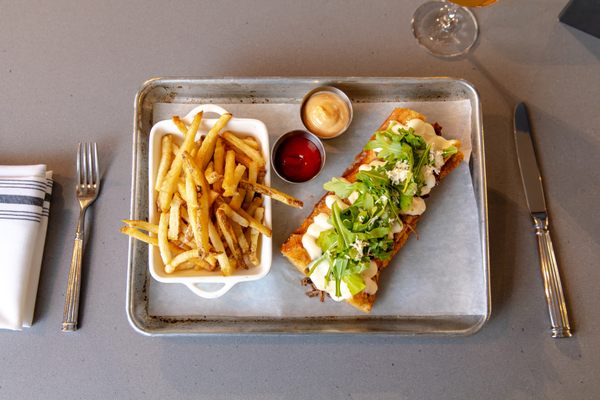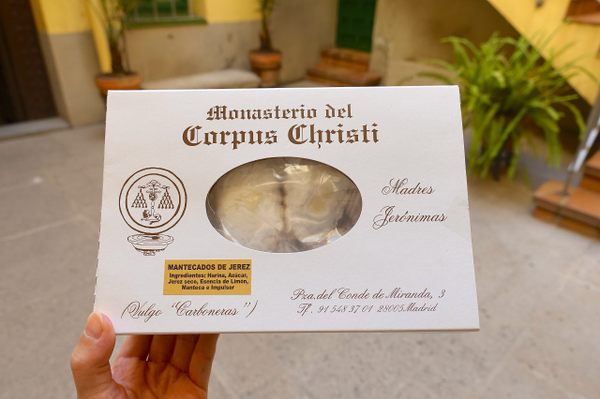Every Summer, Galician Winemakers Turn Their Homes Into Restaurants
What started as a way to sell excess wine has become a beloved custom.
There was a line out front, and a menu. Ham was being sliced, wine was being served, and bills were being paid. But we were not at a restaurant. The dishes were served by local kids. And our dining room was, unmistakably, the standard two-car garage of a two-story home.
I was in Galicia, Spain’s northwestern corner, with Juan Vidal Ventoso and Lorena Cancelas Rodríguez, perhaps the two people most well-equipped to explain this unique culinary experience. Along with Daniel Alvarez Méndez and Ruth Fernández Fernández, they run a website called Guía Furanchín, a guide to furanchos, home-based eateries that pop up each summer in this part of Spain.
According to Ventoso, as far back as the 17th century, winemakers in southern Galicia needed a way to offload excess wine before the next harvest. Locals would hang a bay-leaf branch on their doors as a sign that cheap wine was available. This became known as a loureiro—the local term for bay leaf—or, more commonly nowadays, a furancho.
Furancho is the name for the hole made in a barrel of wine in order to taste its contents. But they’re not just places to drink. “Years ago, furanchos only sold wine,” Ventoso explains, describing venues with dirt floors and no tables—essentially rough, homely bars. “Then people started bringing food. Later, furanchos started to sell simple dishes.”
Fast-forward a few decades. The bay-leaf branches remained, but furanchos were becoming more commercial. Some even became full-fledged restaurants. In 2012, Galicia’s government stepped in, defining what could be called a furancho and providing some basic regulation. Today, there’s a set of rules that determine when a furancho can open (for no longer than three months, and no later than July 31), what dishes can be served and how many (five, from a government approved list of 11) and what drinks can be poured (wine, water, and sweetened carbonated water, but no liquor, beer or soda).

Guía Furanchín, whose name is a cheeky play on the Spanish name for the Michelin Guide, lists more than 60 furanchos in southern Galicia, largely in the semi-rural winemaking areas around Ponte Vedra, Redonda, and Vigo. They range from garages to furanchos that skirt perilously close to proper restaurants. But if there’s a single element linking all furanchos, it’s wine. “If there’s no wine, there’s no furancho,” Ventoso says, explaining that when the previous year’s harvest of wine has been drunk, a furancho is obligated to close.
A furancho’s wine must also be produced in-house, and indeed, on the other side of a wall from our garage-based dining room was the source of our wine: one of the thousands of tiny vineyards that form a patchwork across this green, misty region of Spain.
That evening, at Furancho Berdomas in Redondela, we sample an orange-hued, fruity white wine, as well as a rather chalky, deep purple red. As is standard at furanchos, we sip our wine from cuncas, small ceramic cups that resemble individual soup bowls.
“The wine at each furancho is very different,” Ventoso tells me. “If you go just one kilometer away, the soil, the production, the grapes all mean that the wine will be totally different.”
Ventoso orders food, and from the kitchen—the same kitchen where this family had cooked breakfast that morning—several dishes arrive: slices of cured ham; fried pork short ribs marinated in smoked paprika, garlic, and bay leaf; Spain’s beloved potato-and-egg tortilla; and Padrón peppers seared in olive oil and sprinkled with coarse salt. The dishes weren’t refined, but they were well seasoned and delicious, and for an amateur kitchen run by a family, service was surprisingly efficient. “I like furanchos because the food is like home cooking—like grandma’s food,” Ventoso says. “And it’s cheaper than a restaurant.”
The next day, Ventoso and Rodríguez pick me up at my hotel and we head to Furancho Cadaval, an eatery closer to the restaurant end of the spectrum. After winding over hilly roads lined with granite houses and small vineyards, we spot several cars parked by the side of the road and a bay leaf branch lashed to a telephone pole, indicators that we’re in the right place.
The specialty at Furancho Cadaval is empanadas, stuffed almost exclusively with seafood. Their production is overseen by the 92-year-old matriarch, Maria Sebran Martinez. “We make the empanadas ourselves! We don’t commission anyone to do it!” Martinez tells me. The offerings that evening include her speciality, a cornmeal empanada with a mix of octopus and local tetilla cheese, as well as a standard empanada with cuttlefish and its ink, an empanadilla with salt cod and raisins, and a delicious dessert empanada with apples.
We wander through a cavern-like granite home where dozens of people are dining, and emerge into a sunny backyard outfitted with picnic tables. Rodríguez points out the lack of individual plates—not unusual at a furancho—and between bites, we prop our silverware on hunks of bread.

While eating, we learn that the white wine at Furancho Cadaval is made entirely with fragrant Albariño grapes, a relative luxury in the furancho world (and, at 7 euros for a liter, relatively expensive as well). The red, on the other hand, is unpleasantly tannic, and Juan teaches me the technique of improving subpar wine with a splash of gaseosa, the sweetened fizzy water that’s on nearly every table at a furancho. “If the wine is good, you don’t need gaseosa,” Ventoso tells me.
During dinner, Ventoso, who’s wearing a Guía Furanchín t-shirt, is recognized by some of his online followers. He’s a celebrity in the furancho world, and was spotted at our previous meal as well. He and his fans critique the wine and talk about other furanchos: who’s open, what’s new, who’s breaking the local government’s rules, and where to get the best tortilla.
My final meal with Ventoso and Rodríguez was at Furancho Nati, located in a rural area south of Redondela. At a long table we sip on a funky, fruity, fizzy red and eat boiled pig ears and chorizo made in-house from pigs raised by the owners, and a tortilla made with eggs from their chickens. While we feast, I ask Juan, the furancho host, if he minds opening his house to people. “I have a customer who goes into the kitchen and grabs his own wine,” he replies, seemingly shocked by my question. “I don’t mind!”
Nati was by far the most rustic furancho yet, a garage with bare cinderblock walls, harsh fluorescent lighting, and a blaring TV. Looking around, I was reminded of something Ventoso said at our first meal together. “Freezers in the dining room, bright lights, a 30-year-old TV, mismatched plates,” he rhapsodized. “That’s a furancho.”
Gastro Obscura covers the world’s most wondrous food and drink.
Sign up for our email, delivered twice a week.





























Follow us on Twitter to get the latest on the world's hidden wonders.
Like us on Facebook to get the latest on the world's hidden wonders.
Follow us on Twitter Like us on Facebook